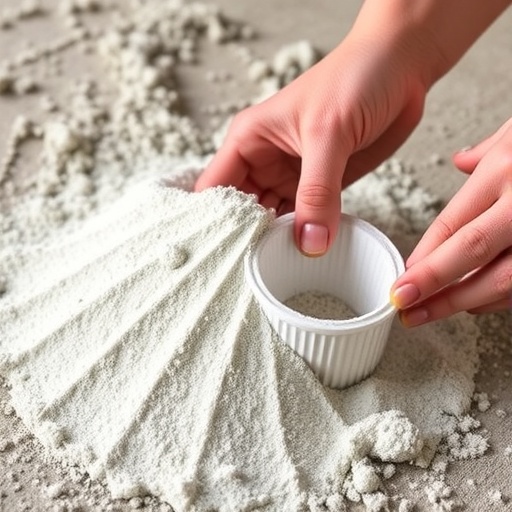In the realm of sustainable construction materials, the exploration of alternative resources is gaining unprecedented momentum. A recent study conducted by Ferreira, Pereira, Diniz, and their colleagues has shed light on the potential of diatomaceous earth waste and by-products as supplementary cementitious materials. This research signifies a pivotal step towards enhancing not only the strength and durability of concrete but also promoting environmental sustainability within the building industry.
Diatomaceous earth, derived from the fossilized remains of diatoms, a type of algae, is traditionally known for its use in filtration and insulation. However, the study conducted by Ferreira and colleagues takes this versatile material a step further by evaluating its utility in cement production. The research explores the properties of diatomaceous earth when integrated into cement mixtures, aiming to assess how these by-products can contribute to reducing reliance on conventional cement.
Cement production is responsible for a significant portion of global carbon dioxide emissions, with estimates suggesting it accounts for up to 8% of total emissions. The environmental implications are alarming, prompting researchers to seek viable alternatives that can help mitigate this impact. Utilizing waste materials like diatomaceous earth not only presents a pathway for reducing emissions but also aligns with the principles of circular economy, where waste is repurposed into valuable resources.
The findings of this research highlight the mechanical properties and durability enhancements associated with incorporating diatomaceous earth into cementitious formulations. The study reveals that when used as a partial replacement for traditional cement, diatomaceous earth can improve aspects such as compressive strength and longevity of concrete. These findings resonate with the construction industry’s ongoing quest for materials that offer superior performance while minimizing ecological footprints.
Furthermore, the study delves into the physicochemical properties of diatomaceous earth, establishing its pozzolanic activity—an essential characteristic for supplementary cementitious materials. Pozzolanic materials react with calcium hydroxide released during the hydration of cement, which results in the formation of additional cementitious compounds that contribute to the overall strength and durability of concrete mixtures. By leveraging the inherent properties of diatomaceous earth, this research opens the door to innovative approaches in concrete formulation.
Collaboration across disciplines is often essential for advancing research in sustainable material science. The investigation undertaken by Ferreira’s team draws upon expertise from various fields, including environmental science, chemistry, and materials engineering. This interdisciplinary approach enhances the depth of analysis and promotes comprehensive understanding, contributing to the robustness of the research findings.
The implications of these results extend beyond technical specifications. As cities around the world continue to expand, there is an increasing demand for infrastructure that can withstand the test of time while being environmentally conscious. The integration of diatomaceous earth waste into cement could play a crucial role in meeting these demands, offering a blend of strength, sustainability, and cost-effectiveness in construction practices.
In addition to mechanical and durability aspects, the study addresses the cost efficiencies associated with utilizing diatomaceous earth as a supplementary material. With construction costs on the rise, finding feasible alternatives is of paramount importance. By incorporating waste materials, not only can builders potentially lower material costs, but they also significantly reduce waste sent to landfills—a win-win for both the industry and the environment.
The researchers emphasize the importance of further investigations to optimize the use of diatomaceous earth in diverse construction applications. Future research directions may include examining the long-term performance of concrete containing diatomaceous earth and exploring its potential in various environmental conditions. Such avenues will not only solidify the role of these materials in the construction sector but also enhance regulatory frameworks surrounding sustainable building practices.
Ultimately, the pioneering work by Ferreira, Pereira, and Diniz serves as a clarion call to the construction industry. It emphasizes the need for innovation and the exploration of alternative materials as a means to address pressing environmental challenges. By harnessing the potential of diatomaceous earth waste and by-products, the industry can take significant strides towards reducing its carbon footprint while improving the quality of built environments.
This study stands as a testament to the transformative power of research in sustainable development. As the world grapples with climate change and resource scarcity, the merits of integrating waste materials into essential construction practices resonate more profoundly than ever. It invites stakeholders—from policymakers to engineers—to consider the sustainable pathways that emerge from such innovative research.
In conclusion, Ferreira et al.’s study on diatomaceous earth waste and by-products illuminates a promising frontier in the quest to revolutionize the construction industry. The findings underscore the critical interplay between sustainability and material science, offering solutions that can help build a greener future for generations to come. As awareness grows and technology evolves, the transition towards more sustainable construction methodologies becomes not just a possibility but a necessity.
Subject of Research: Potential of diatomaceous earth waste as supplementary cementitious material.
Article Title: Evaluating the use of diatomaceous earth waste and by-products as a supplementary cementitious material.
Article References:
Ferreira, R., Pereira, J., Diniz, H. et al. Evaluating the use of diatomaceous earth waste and by-products as a supplementary cementitious material.
Environ Sci Pollut Res (2025). https://doi.org/10.1007/s11356-025-36905-3
Image Credits: AI Generated
DOI: 10.1007/s11356-025-36905-3
Keywords: Diatomaceous earth, supplementary cementitious materials, sustainability, construction industry, carbon footprint reduction.




